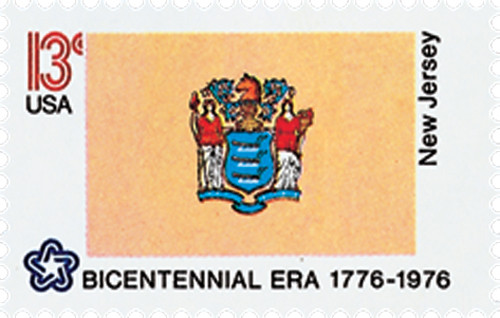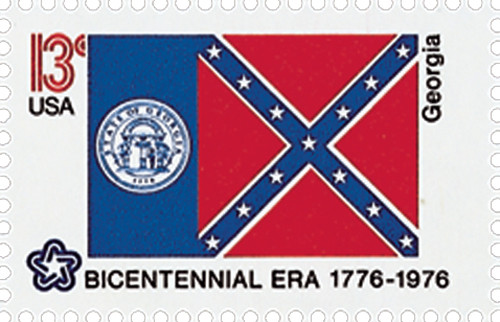
# 1638 - 1976 13c State Flags: Massachusetts
U.S. 1638
1976 Massachusetts State Flag
State Flags
American Bicentennial Series
• First time a sheet 50 had all different stamp designs
• Part of the American Bicentennial Series
Stamp Category: Commemorative
Series: American Bicentennial Series
Value: 13¢ First-class postage rate
First Day of Issue: February 23, 1976
First Day City(s): Washington, DC
Quantity Issued: 8,720,100 (panes of 50)
Printed by: Bureau of Engraving and Printing
Printing Method: Photogravure
Format: Sheet of 50
Perforations: 11
Why the stamp was issued:
The United States Postal Service celebrated the American Bicentennial with a full pane of the Union’s fifty state flags.
About the stamp design:
In 1915, the flag of Massachusetts was officially unfurled. Written on it was the motto, “By the sword we seek peace, but peace only under liberty.” The motto was adopted by Massachusetts Provincial Congress in 1775 – the same year that the “shot heard round the world” was fired. Although the current version of the flag was not ratified until 1971, the motto has embodied the spirit of Massachusetts for over 200 years.
On the white flag is a blue shield with a Massachuset Native American in the middle. He has a bow and arrow with the arrow facing down, which represents peace. A white star is located on the upper left of the shield is representative of one of the original thirteen states.
About the printing process:
Printed by the Bureau of Engraving and Printing on their seven-color Andreotti gravure press (601) which was their work horse for multicolored stamps.
About the American Bicentennial Series:
In the 1970s, America celebrated its 200th anniversary with hundreds of national events commemorating the heroes and historic events that led to our nation’s independence from Great Britain. The U.S. Postal Service issued 113 commemorative stamps over a six-year period in honor of the U.S. bicentennial, beginning with the American Revolution Bicentennial Commission Emblem stamp (U.S. #1432). As a group, the Bicentennial Series chronicles one of our nation’s most important chapters, and remembers the events and patriots who made the U.S. a world model for liberty.
Several of the stamps honored colonial life – craftsmen and communication. Other stamps honored important battles including Lexington and Concord, Bunker Hill, and Saratoga. Significant events such as the Boston Tea Party, the meeting of the First Continental Congress, and the Declaration of Independence were featured as well. The stamps also honored many significant people such as George Washington, Sybil Ludington, Salem Poor, and the Marquis de Lafayette.
Many of the stamps feature classic artwork. For instance, the set of four souvenir sheets picture important events recreated by noted artists such as John Trumbull. The Bicentennial Series also includes an important US postal first – the first 50-stamp se-tenant – featuring all 50 state flags. The format proved to be popular with collectors, and has been repeated many times since.
The American Bicentennial Series is packed with important US history – it tells the story of our nation’s fight for independence through stamps.
History the stamp represents:
On February 6, 1788, Massachusetts became the 6th state to join the Union.
Native Americans lived in the Massachusetts region for more than 3,000 years. In 1614, English sea captain John Smith sailed along the coast of Massachusetts. Smith’s book, “A Description of New England,” guided the Pilgrims to Massachusetts.
On September 16, 1620, 41 Separatists and 61 others seeking religious freedom journeyed to America. These Pilgrims sailed from Plymouth, England, aboard the Mayflower. That November, they landed in what is now known as Provincetown Harbor. Before they set foot on land, the Pilgrims drew up the Mayflower Compact – the first agreement for self-government ever put into writing in America.
The American Revolution began in Massachusetts, and the majority of the early fighting took place in its territory. Massachusetts soldiers fought bravely in the first battles of the war, which included Lexington, Concord, and Bunker Hill. In the spring of 1776, General George Washington drove the British out of Boston. This marked the first major Colonial victory of the war. Massachusetts supplied a large number of the soldiers who fought in the war, and ships from the state inflicted heavy damage on British merchant ships. In 1783, the British signed the Treaty of Paris, which recognized the independence of the United States, and ended the war.
On February 6, 1788, Massachusetts ratified the United States Constitution and became the sixth state to join the Union. As part of the ratification process, the state insisted that certain measures concerning individual rights be added to the document. On December 15, 1791, the Bill of Rights became an important part of the “Law of the Land.”
U.S. 1638
1976 Massachusetts State Flag
State Flags
American Bicentennial Series
• First time a sheet 50 had all different stamp designs
• Part of the American Bicentennial Series
Stamp Category: Commemorative
Series: American Bicentennial Series
Value: 13¢ First-class postage rate
First Day of Issue: February 23, 1976
First Day City(s): Washington, DC
Quantity Issued: 8,720,100 (panes of 50)
Printed by: Bureau of Engraving and Printing
Printing Method: Photogravure
Format: Sheet of 50
Perforations: 11
Why the stamp was issued:
The United States Postal Service celebrated the American Bicentennial with a full pane of the Union’s fifty state flags.
About the stamp design:
In 1915, the flag of Massachusetts was officially unfurled. Written on it was the motto, “By the sword we seek peace, but peace only under liberty.” The motto was adopted by Massachusetts Provincial Congress in 1775 – the same year that the “shot heard round the world” was fired. Although the current version of the flag was not ratified until 1971, the motto has embodied the spirit of Massachusetts for over 200 years.
On the white flag is a blue shield with a Massachuset Native American in the middle. He has a bow and arrow with the arrow facing down, which represents peace. A white star is located on the upper left of the shield is representative of one of the original thirteen states.
About the printing process:
Printed by the Bureau of Engraving and Printing on their seven-color Andreotti gravure press (601) which was their work horse for multicolored stamps.
About the American Bicentennial Series:
In the 1970s, America celebrated its 200th anniversary with hundreds of national events commemorating the heroes and historic events that led to our nation’s independence from Great Britain. The U.S. Postal Service issued 113 commemorative stamps over a six-year period in honor of the U.S. bicentennial, beginning with the American Revolution Bicentennial Commission Emblem stamp (U.S. #1432). As a group, the Bicentennial Series chronicles one of our nation’s most important chapters, and remembers the events and patriots who made the U.S. a world model for liberty.
Several of the stamps honored colonial life – craftsmen and communication. Other stamps honored important battles including Lexington and Concord, Bunker Hill, and Saratoga. Significant events such as the Boston Tea Party, the meeting of the First Continental Congress, and the Declaration of Independence were featured as well. The stamps also honored many significant people such as George Washington, Sybil Ludington, Salem Poor, and the Marquis de Lafayette.
Many of the stamps feature classic artwork. For instance, the set of four souvenir sheets picture important events recreated by noted artists such as John Trumbull. The Bicentennial Series also includes an important US postal first – the first 50-stamp se-tenant – featuring all 50 state flags. The format proved to be popular with collectors, and has been repeated many times since.
The American Bicentennial Series is packed with important US history – it tells the story of our nation’s fight for independence through stamps.
History the stamp represents:
On February 6, 1788, Massachusetts became the 6th state to join the Union.
Native Americans lived in the Massachusetts region for more than 3,000 years. In 1614, English sea captain John Smith sailed along the coast of Massachusetts. Smith’s book, “A Description of New England,” guided the Pilgrims to Massachusetts.
On September 16, 1620, 41 Separatists and 61 others seeking religious freedom journeyed to America. These Pilgrims sailed from Plymouth, England, aboard the Mayflower. That November, they landed in what is now known as Provincetown Harbor. Before they set foot on land, the Pilgrims drew up the Mayflower Compact – the first agreement for self-government ever put into writing in America.
The American Revolution began in Massachusetts, and the majority of the early fighting took place in its territory. Massachusetts soldiers fought bravely in the first battles of the war, which included Lexington, Concord, and Bunker Hill. In the spring of 1776, General George Washington drove the British out of Boston. This marked the first major Colonial victory of the war. Massachusetts supplied a large number of the soldiers who fought in the war, and ships from the state inflicted heavy damage on British merchant ships. In 1783, the British signed the Treaty of Paris, which recognized the independence of the United States, and ended the war.
On February 6, 1788, Massachusetts ratified the United States Constitution and became the sixth state to join the Union. As part of the ratification process, the state insisted that certain measures concerning individual rights be added to the document. On December 15, 1791, the Bill of Rights became an important part of the “Law of the Land.”


















